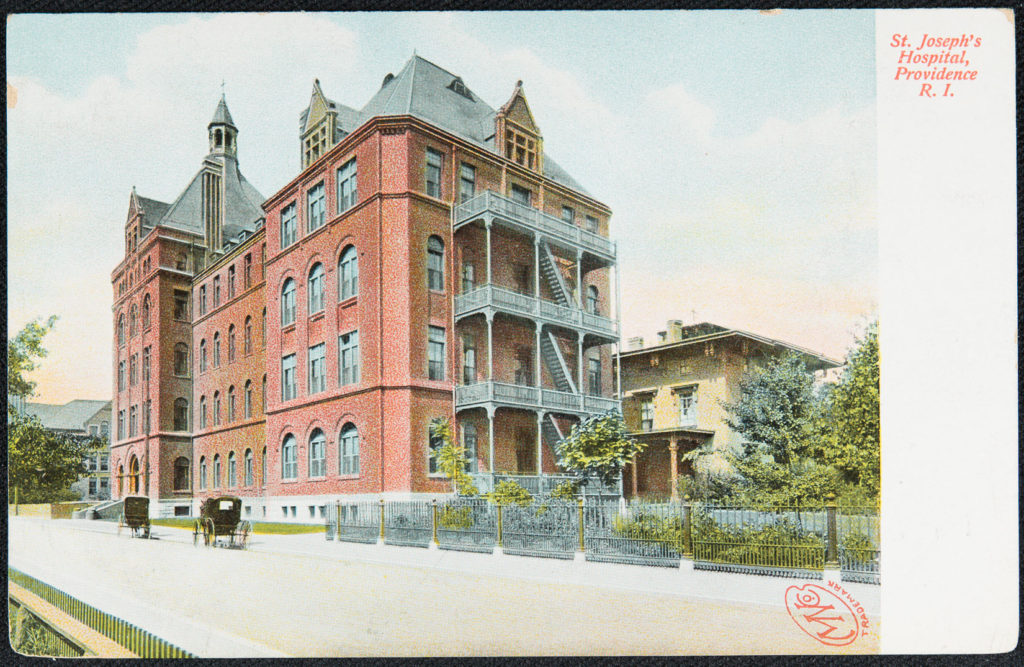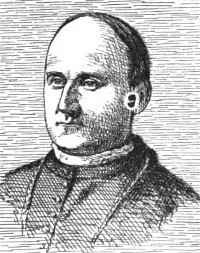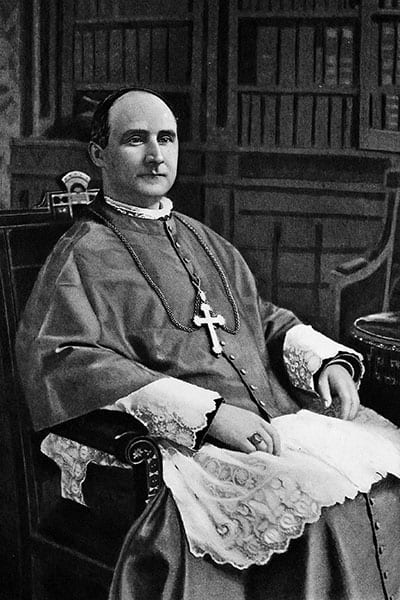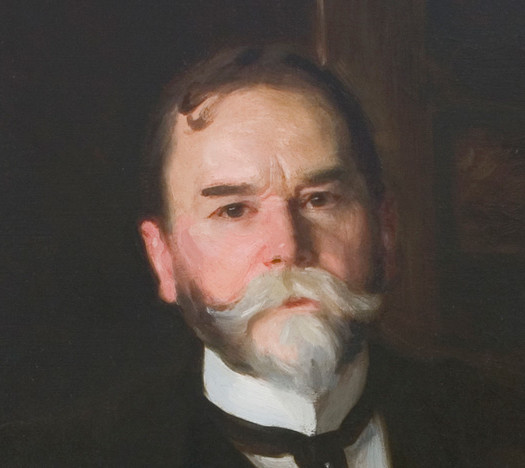This essay, on the character of Bishop Harkins and his career as an administrator, and on the bishop’s social apostolate, were written in 1978 for the projected second volume of my history of Rhode Island Catholicism. A third essay, detailing Harkins’s educational achievements, including the founding of Providence College, has already been published as “Matthew Harkins: Catholic Bishop and Educator” in Rhode Island History 53 (August 1995), 70-89. The bulk of this article is from Patrick T. Conley, Rhode Island in Rhetoric and Reflection, Public Addresses and Essay (Rhode Island Publications Society, 2002).
The death of Bishop Thomas F. Hendricken on June 11, 1886, created a void in the Archdiocese of Boston that Archbishop John Williams moved to fill. On July 8 he convened a meeting of the suffragens of the province to nominate a successor to the vacancy, which was under the temporary administration of the vicar general, the Very Reverend Michael McCabe of St. Charles, Woonsocket. When the bishops assembled, several clerics were discussed, but the first three candidates suggested were rejected for being “too old,” “in poor health,” and “unfit.”
Bishop James A. Healy of the Diocese of Portland, Maine, then made his presence felt. Healy, the first black prelate in the United States, was the son of Michael Healy, an Irishman who emigrated to Georgia in 1823, and Michael’s black slave Eliza. The marriage of this couple produced ten children, three of whom became priests, while two daughters entered the sisterhood. James came north with his family, graduated from Holy Cross with honors, received ordination in 1854, and eventually because the pastor of the important parish of St. James in Boston. From this post he was elevated to the bishopric of Portland in 1875.
It was Bishop Healy’s decision to sponsor Matthew Harkins, the pastor of St. James’s Church, whose seventeen thousand members made it the largest parish in New England. A general discussion followed this proposal, after which young Harkins was nominated as Hendricken’s successor by a majority vote. When Archbishop Williams forwarded the names of three candidates to Rome after the selection session was concluded, he underscored Harkins as his personal choice. “I know the Rev. Matthew Harkins,” he wrote, “and can nominate him without reservation. He has all the qualities for the place.”
Rome honored the wishes of Williams and Healy, and five months later Father Harkins received word that he had been chosen to become the second bishop of Providence. His reaction, recorded in his diary, was characteristically humble but uncharacteristically apprehensive: “This news causes me a great sorrow. I feel utterly unworthy of such a dignity and incapable of properly discharging its duties. What shall I do? God only knows.”
On April 14, 1887, before an enormous throng including some five hundred priests from New England and beyond, Father Harkins was consecrated at the new Cathedral of SS. Peter and Paul. Archbishop Williams, who officiated, admonished the audience to “take good care of him; he’s the best we’ve got.” Bishop Healy, who preached the sermon, agreed. Harkins would vindicate the confidence of his sponsors during his thirty-four year administration, so much so that his close friend Healy would one day attempt to secure for Harkins the prestigious post of archbishop of Boston.
Despite his own reservations and self-doubts, Harkins had been prepared in superb fashion for his duties in Rhode Island. Born in Boston on November 17, 1845, to Patrick and Mary Margaret (Kranich) Harkins, the future bishop received a public education and graduated from the Quincy School with a Franklin Medal for the highest academic achievement. After completing studies at Boston Latin, Harkins attended Holy Cross for a year and then, in 1863, went abroad to study under the Benedictine Fathers at the English College at Douai, France. Like so many other American clerics, he was ordained at the Seminary of St. Sulpice, Paris.
After his ordination on May 22, 1869, Harkins spent over a year at the Gregorian University in Rome, where he engaged in further theological study, witnessed the Vatican Council, and became conversant in Italian. In 1870 he returned to his native diocese of Boston and was soon assigned to the Church of the Immaculate Conception at Salem. Here he gained valuable experience in ethnic relations, which he would apply with consummate skill in later years.
His first parish contained a growing number of French Canadians, lured south by the prospect of employment in the growing North Shore textile industry. Their inability to speak English led Father Harkins, who could read, write, and speak the French language fluently, to conduct the first Mass in the French vernacular at Salem on June 30, 1872. Witnesses commented that “he spoke with a great facility.” After this auspicious beginning, Harkins was entrusted with the spiritual welfare of the French parishioners and began the practice of celebrating the nine o’clock Mass every Sunday in French. He also began a Sunday school for the French Canadian youth of the parish. In May 1873 Harkins turned these functions over to a new French Canadian curate, but whenever the new cleric was absent, Father Harkins “watched over the interest of the French people.”
It was at Salem, too, that this zealous young priest began working with the impoverished people of the parish. He mobilized the ladies to conduct an extremely successful clothing campaign during the harsh winter of 1873-74. Harkins would retain this concern for the downtrodden throughout his life, eventually earning the title “Bishop of the Poor.”
Williams recognized Harkins’s exceptional abilities in April 1876 by elevating him to the pastorate at St. Malachi’s Church in Arlington, Massachusetts. When the young priest relinquished his Salem assignment, his pastor enthusiastically noted Harkins’s special qualities: “I have lived for years among priests, old and young, and never have I seen one more faithful to all his duties than Father Harkins.”
Success in Arlington earned the future bishop another promotion by 1884, this time to the prestigious church of St. James in Boston. During that same year he accompanied Archbishop Williams to the Third Plenary Council at Baltimore as the archbishop’s theologian. Two years later Williams appointed him to the important posts of consultor and synodal examiner.
In 1887 Matthew Harkins was ready to assume the duties of the episcopacy in his own right. Those who knew this second bishop of Providence when he commenced his term described him as five feet six inches tall and “strong and compact in build.” He was dark-complexioned with “thinning dark hair” and aquiline features, a man who “scarcely looks his forty years.” His piercing eyes “beam with intelligence,” said another observer, and “he speaks with ease and fluency; and one would never tire of him.”
Harkins came to his new post with an enormous capacity for work and exceptional organizational ability–traits that the Providence Visitor called “his strongest executive qualifications.” The new bishop, who would guide the Providence diocese for more than thirty-four years, was also described as “a man of acute mind, extremely well-informed, by nature rather retiring and simple, and full of disdain for show and vain pretensions.” He was ambitious and assertive but self-effacing. Harkins disliked fanfare intensely, and as bishop of Providence he felt that he should “avoid publicity.” This characteristic would remain constant throughout his lifetime. Thirty years later he became upset over the suggestion that the Catholic college he proposed for his diocese should be named in his honor.
Harkins was a man of proven intelligence, but his letters reveal that he was very unsure of his rhetorical abilities. Although the press praised his oratorical efforts, his feelings of inadequacy in this area led him to avoid whenever possible the task of preaching before a large audience. “The few times that I have spoken outside of my own church,” he confided to Archbishop Williams, “have convinced me that I am totally unfit for a sermon or an important or more solemn celebration.” To an old friend, Bishop Charles E. McDonnell of Brooklyn, Harkins also confessed his “very little facility in composition” and his “almost complete lack of imagination.”
But if Harkins was not eloquent, he was certainly persuasive, for he rarely failed to strike a responsive chord in his various charitable appeals. Among his more successful special campaigns were those to aid victims of the San Francisco disaster of 1906, the eruption of Italy’s Mt. Vesuvius in the same year, and the Italian earthquake of 1908. He was also vitally concerned with the support of the foreign missions. After the fund drive of 1895, Harkins could reflect with satisfaction that more money for foreign missions had been raised in his Diocese of Providence than in any other American diocese of comparable size.
Harkins was a compassionate man, but he was also businesslike and somewhat authoritarian, especially to the religious under his supervision. He was acutely sensitive to the leadership position of parish priests and would neither condone nor permit any relaxation of his exacting standards. Financial irresponsibility resulted in suspension or in a request for the resignation of the erring cleric. Effective management and organizational ability, Harkins’s strong points, were expected of his priests as well. Inefficiency was intolerable to the bishop; he removed one priest for “notorious and injurious incapacity” and suspended another for failing to submit required reports. If a cleric displayed a lethargic approach towards his work, he was promptly transferred to another post where his new pastor could call “to his attention anything in his conduct that should be corrected–and likewise to quicken his zeal from time to time.”
Disobedience was dealt with harshly by Harkins. He threatened one nun with expulsion for failing to walk in the appointed manner from the school where she taught to her convent. “I prefer to have no further relation with you,” he crisply wrote to a religious student who had left college without his permission.
Harkins was no ecumenist; but then neither were most of his non-Catholic contemporaries. Toward other religious groups, and toward organizations without Catholic membership or representation, Harkins remained cool and aloof. He withdrew official Catholic support and involvement from the Pawtucket Cotton Centenary in 1890 because Protestant ministers were scheduled to address the audience, which would include Catholic schoolchildren. Characteristically, he refused press interviews concerning the issue. He declined to participate at the cornerstone laying at the new State House in 1896 because “the ceremonies had been entrusted to the Masonic Fraternity.” In the following year he expressed his disapproval to Providence politician Patrick J. McCarthy over the Protestant makeup of the Providence Public Library’s board of trustees, and in 1899 he chastised a priest for participating in a Methodist funeral, calling services of this kind “heretical forms of worship.” Harkins also refused to join the interdenominational Federation of Churches and was sharply criticized for that refusal. Since this was the era of the anti-Irish Catholic American Protective Association and continuing political nativism on the state and local level, Harkins’s hypersensitivity to the inferior status of Catholics in Rhode Island is not surprising. In sum, Harkins manifested an attitude that some sociologists have described as “fortress Catholicism.”
While the bishop could sometimes become embroiled in local issues, he generally avoided comment on national affairs. He preferred, it seems, to allow the Visitor, under the successive direction of such learned individuals as Fathers John Tennian, Henry F. Kinnerney, Austin Dowling, and George Parsons Lathrop, to expound upon national and international concerns. Neither Harkins’s diary nor his letters reflect much opinion on the broader issues of the day, but this localism was somewhat typical of the American hierarchy in that period of internal growth and development.
Two notable departures from his relative silence on national affairs occurred with his political support for the nation’s involvement in the Spanish-American War and World War I. In the midst of the first conflict, facetiously referred to by one diplomatic historian as “America’s Coming-Out-Party,” Harkins correctly predicted the emerging role of the United States in world affairs. In a Fourth of July 1898 address, delivered at the dedication of a school in St. Charles’s Parish, Woonsocket, he observed that the United States was “approaching a crisis in its history, when she emerges from the retirement she has so long occupied as a colony and an independent nation on this side of the Atlantic to a prominent place in the field of international politics.” He concluded that this country, by virtue of her new position in international affairs, would become “a known and recognized power among all the nations of the earth.”
The perspective of time has proven that this era was indeed a watershed in American history wherein we abandoned our traditional nineteenth-century policies of neutrality, isolationism, and hemispheric exclusiveness and assumed an active and directing role in world affairs. Harkins was most perceptive in identifying this transition, and his remarks on this occasion seem to indicate that his silence on national issues was the result of choice rather than ignorance.
With the involvement of America in World War I, Bishop Harkins again took a public stance when he urged the wholehearted support of the diocese “in our battle to rid the world of the power of a nation that knows no law but that of might.” He also considered the war a significant test of Catholic patriotism–an opportunity for an enduring testament of Catholic support for American national aims. We are living in an age of fact, he stated, and “evidence must be on hand to prove to succeeding generations . . . the extent of Catholic response to the call to arms.” Harkins feared that the so-called “hyphenated Americans” of German and Irish descent would resist this country’s participation as an ally of England in a war against Germany. Such reluctance by these groups did, in fact, bring a nativistic response during the postwar era in the form of “100 percent Americanism,” and it was just such a situation that Harkins was attempting to avoid by his stirring pastoral letter of 1918.
The Catholic group that responded most vigorously to the war effort both in Rhode Island and the nation was the Knights of Columbus, but the Ancient Order of Hibernians was less than enthusiastic. That Irish fraternal order became totally disenchanted with President Wilson when he refused to back self-determination for Ireland in the postwar settlement.
These very infrequent forays into the national arena did not deter Harkins from his major role–the building of the Diocese of Providence. The influx of the so-called “new immigration,” the social needs of his working-class flock, and the educational mandates of the Third Plenary Council of Baltimore preoccupied him and challenged his enormous administrative ability. In the first two endeavors–accommodation of the immigrant and social work–he was aided especially by the Society of St. Vincent de Paul. For all three tasks he called upon numerous religious orders for assistance. Over two dozen such groups were established in the diocese by Harkins and enlisted in his social and educational crusade. Half of the present orders now operative in Rhode Island trace their local origins to Bishop Matthew Harkins.
Since his early days at the Immaculate Conception Church in Salem, Massachusetts, Matthew Harkins had demonstrated a deep commitment to social action. As bishop of Providence, he translated this social consciousness into positive programs and permanent institutions to serve the needs of his people from their infancy through old age. Many of the social agencies he founded have closed, but their value to their own generation was substantial.
Perhaps Harkins’s largest and most flourishing project was St. Joseph’s Hospital in Providence. It was also his most ambitious undertaking. On August 1, 1891, he purchased the old Harris Estate on Broad Street in what was then a fashionable section of Providence as the site for his proposed hospital. The Harris mansion, facing on Broad Street between Plenty and Peace Streets, was renovated and converted into wards and private rooms. On March 19, 1892, the feast of St. Joseph, the facility was dedicated, and three weeks later, on April 6, the first patient was admitted. By 1903, it was providing free care to needy patients amounting to 25,088 days.

St. Joseph’s Hospital in Providence, dedicated in 1892 and founded by Bishop Matthew Harkins (Providence Public Library Digital Collection)
Harkins left many other social monuments as well. For infants, he sponsored the St. Vincent de Paul Asylum (Providence, 1891); for young children, l’Orphelinat St. François (Woonsocket, 1904), the St. Vincent de Paul Home (Woonsocket, 1905), and the Mercy Home and School (Newport, 1915); for young working males, the Rhode Island Home for Working Boys (Providence, 1899); for their female counterparts, St. Maria’s Home for Working Girls (Providence, 1890) and its affiliate, St. Margaret’s Home (Providence, 1905); for wayward and delinquent girls, the House of the Good Shepherd (Providence, 1905); and as a summer vacation spot for needy children, Tower Hill House (South Kingstown, 1907)
Nor did Harkins neglect the poor, the sick, the elderly, the working mother, or the immigrant. St. Joseph’s Convent (Pawtucket, 1905), the Nazareth Home (Providence, 1907), and St. Clare’s Home (Newport, 1908) provided visiting-nurse service to the poor, and the latter two also served as day-care centers for the children of working mothers. L’Hospice St. Antoine (Woonsocket, 1913) ministered to the aged poor. There were, in addition, three day nurseries established for the benefit of the Providence Italian community, St. Ann’s (1914), Scalabrini (1916), and St. Raphael’s (1916). The St. Raphael’s facility had also operated an industrial school for girls and a visiting nurse service since its initial incorporation in 1909 under the guidance of the Franciscan Missionaries of Mary.
It would be neither an exaggeration nor a slight to other able Catholic leaders to assert that Harkins made a greater and more enduring impact upon Catholicism in Rhode Island than anyone before or since.
[Banner image: St. Joseph’s Hospital in Providence, dedicated in 1892 and founded by Bishop Harkins (Providence Public Library Digital Collection)]



























